In 2000, a US Navy senior officer visiting my ship looked me in the eye and said with absolute certainty, “in ten years, all US Navy fighter jets will be uncrewed”.
I was berthed in Reykjavik at the time and he came aboard for lunch as the boss of Naval Air Station Keflavik a few miles down the road. Four ranks senior to me and a fixed-wing aviator himself, I had no reason to doubt him.
Here we are, some twenty-four years later, and the US Navy has finally taken delivery of the first of 76 MQ-25 Stingray autonomous Carrier Based Aerial Refuelling System (CBARS). These are the first in-service unmanned jet aircraft intended to make catapult takeoffs and arrested landings from and on US Navy carriers.
There are two reasons it has taken so long.
The first is that landing on an aircraft carrier using an arrestor wire, the US Navy’s preferred method, is difficult. Given how naval aviators throughout my seagoing career got paid more for doing less work than me I traditionally cut them little slack when it comes to their tales of derring-do, but RAF colleagues of mine who have done fast jet deck landings on exchange with the USN have done a good job of convincing me that it is the hardest thing you can do in aviation, times ten at night. Fair enough.
The technical challenge of automating this difficult feat was overcome some time ago, however. The first fully automated deck landing systems fitted to manned jets were trialled successfully way back in 1957, and the technology has been refined through several generations since. The main US Navy fighter jet today, the F/A-18E/F Hornet, has automated landing equipment fitted as standard. The auto-landing equipment has just one serious problem: US Navy pilots and their command structure simply refuse to use it. The entire punishment-and-reward culture of a carrier air wing is built around the grades awarded to pilots for manually controlled landings, and US Navy aviators measure their stature by the number of manual ‘traps’ they have made. New pilots are often forbidden to use the automated system by their commanding officers, and any pilot would be regarded with suspicion by his fellow aviators for using it at all often.
But it’s always possible to just do away with the pilots altogether. The X-47B unmanned demonstrator programme made its first arrested deck landing and catapult launch off the USS George H W Bush back in July 2013. These landings were not totally glitch-free, but then neither are human ones. It had been demonstrated that a jet drone with a stealthy shape could indeed conduct arrested deck landings at least as reliably as manned jets on manual could. Not long after this the project passed its other major test, air-to-air refuelling – another tricky piloting feat, though not as difficult as arrested ‘traps’ on deck. Then the X-47B was quietly shelved.
Here we get to the second reason for the delay – turkeys don’t vote for Christmas. The US Navy is a carrier aviation-led institution. Its Nimitz-class and Ford-class supercarriers are all commanded by former fixed-wing aviators, most of whom then go on to become admirals.
Why would they be in any rush to implement a technology that makes their entire service community redundant? It’s possible that the X-47B project only lasted as long as it did due to external pressure from outside the navy. The US Air Force, probably even more (not surprisingly) dominated by pilot culture, shut down its equivalent X-45 project even faster.
As is always the case though, technological difficulties and cultural resistance can be overcome when financial conditions demand it, and this is where we are now with the handover from Boeing to the Navy of the first MQ-25.
Operationally, having an automated refuelling aircraft makes a lot of sense. They can stay airborne for longer and carry more fuel than the current solution, F/A-18 fighters carrying refuelling pods (the extra weight of which reduces their airframe life). This will increase the range and duration of strike sorties, increase deck cycle flexibility and free up valuable F/A-18s for their primary purpose – strike.
It is also one less person to pay, train, keep deck-current and have their ego stroked. Possibly the greatest advantage of unmanned deck landing technology is that you don’t have to burn up huge amounts of expensive carrier and jet time qualifying and re-qualifying pilots.
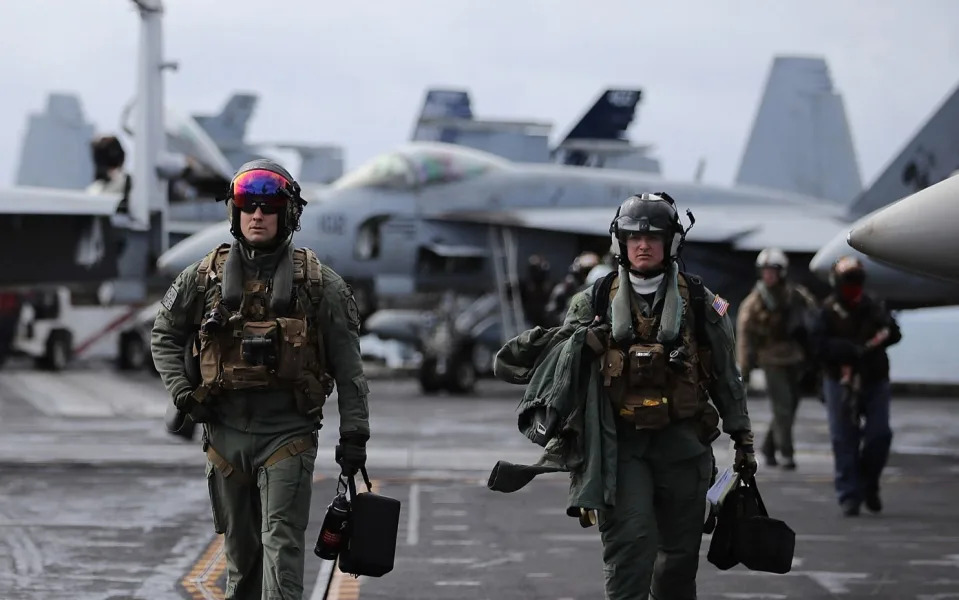
The MQ-25 will be able to refuel the F/A-18 Super Hornet, E-2D Hawkeye and F-35C Lightning II. The official announcement doesn’t mention it, but it is fair to assume that MQ-25s will also be able to refuel F-35B jump jets as operated by the US Marines and British forces, which is good news from an interoperability standpoint (and given British carriers’ lack of any refuelling-capable aircraft). The MQ-25s will be fifth-generation stealthy (equivalent to the F-35s, far better than the F/A-18) and will be able to conduct other surveillance and reconnaissance missions whilst airborne. Given that they will be fully automated, ie not remotely piloted, survivability will be interesting particularly when flying in environments where drones are considered fair game: but Stealth will help with this and tolerance for unmanned aircraft losses is much higher than for manned ones. MQ-25s are likely to be the real-world first choice for reconnaissance into dangerous airspace just for this reason.
The announcement also confirms what military analysts have known for ages – that ‘uncrewed’ is the unambiguous direction of travel for military aviation systems.
‘How fast?’ remains up for debate though. Some projects are moving too quickly, such as the UK selling off its crewed minehunter ships in favour of an impressive-but-not-ready remotely operated system: a move which would seem to be motivated by cost savings rather than capability.
Development of offensive drone systems above, on and below the waves is an area where Nato navies are moving too slowly. We have practised defending against variations of this for decades courtesy of the Iranian threat, but developing systems of drones for offensive operations is lagging whilst Ukraine demonstrates time after time in the Black Sea that it shouldn’t. Lots of teams, units and squadrons are popping up here and in the US to work on this which is excellent, but as ever, funding remains the limiting factor when it comes to pace and mass.
The legal and rules of engagement implications of this increase in uncrewed technology is interesting. Often, rules of engagement forbid the use of already existing weapons which decide for themselves whether they have a legitimate target, such as anti-tank and anti-shipping munitions which can be set to simply scan a given area for apparent tanks and warships and attack any they may find. There may not be any requirement for human input in actually operating an aircraft or a ship, but there may well be a need for a human to decide that a given target should be struck.
The addition of the MQ-25 to the US Navy’s already formidable arsenal is a significant development; both operationally but also how it exemplifies the inevitable march to uncrewed systems, no matter how much those making the decisions might not like it. The MQ-25 is not cheap at about $125 million each for the first batch, a price that is more likely to be acceptable if it is seen as a forerunner to a Strike-capable follow-on. How long before plans for these mature (and are released) will be interesting to watch. Arrested landing is no longer a problem which leaves culture and initial funding as the only stoppers.
As technology increasingly made aircrew backseaters redundant a senior RN pilot once said, “I’ve never taken off with an observer/navigator on board when I wouldn’t rather have had the same weight of fuel”.
The acceptance of the MQ-25 into the USN suggests that we are one step closer to this being true of pilots too.
Super Hornet fighter jets on the deck of a US Navy aircraft carrier in the Red Sea are sporting Houthi drone kill marks
-
US Navy fighter jets have spent months fending off Houthi threats around the Red Sea.
-
Some of the aircraft have been seen sporting kill marks for the drones that they've shot down.
-
The drone silhouettes appear to resemble the KAS-04, or Samad, system.
US Navy fighter aircraft that have been battling Houthi drones and missiles around the Red Sea appear to be sporting kill marks reflecting the threats they've eliminated.
A photo published by the Navy last week shows the silhouettes of two drones and 11 munitions painted on the side of an F/A-18E Super Hornet on the deck of the aircraft carrier USS Dwight D. Eisenhower, a lead ship in the US military's response to the ongoing Houthi attacks off the coast of Yemen.
The drone silhouettes painted on the side of the Navy Super Hornet appear to resemble the Houthis' KAS-04 system. The US military confirmed in November that it shot down an Iranian-made KAS-04, which is also known as a Samad drone, but for the most part, the model of drones that American forces engage has not been disclosed.
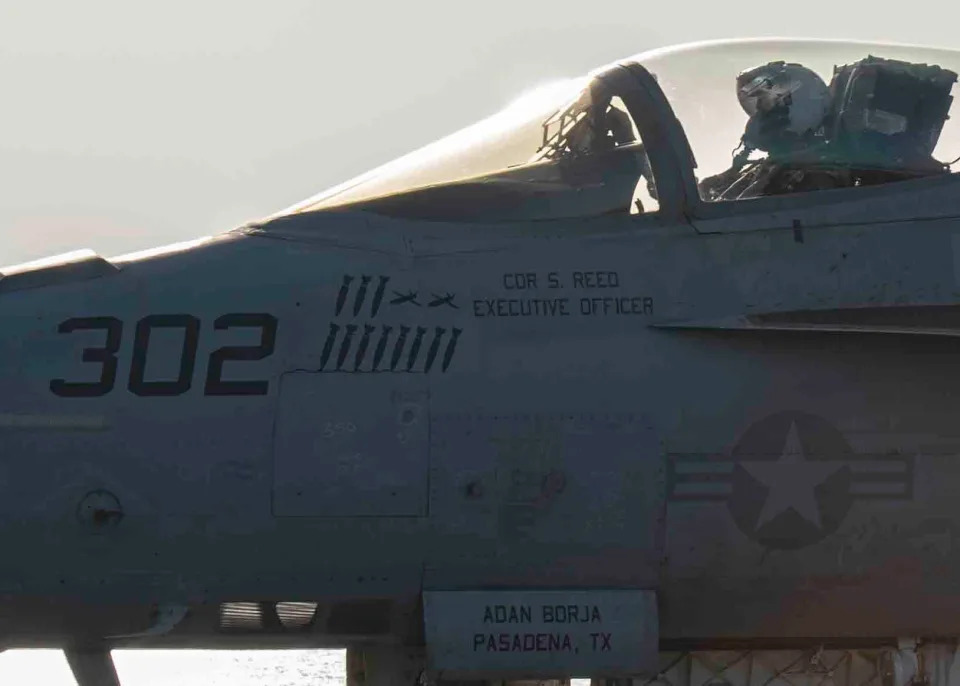
Fighter jets belonging to the Eisenhower's carrier air wing, like the Super Hornet pictured, have been tasked with intercepting Houthi threats in the air and also bombing the Iran-backed rebels directly in Yemen through a mix of both unilateral preemptive strikes and coordinated strikes with US allies.
The munitions painted on the Super Hornet in last week's Navy photo appear to signal the number of bombs dropped by the aircraft in such strikes, according to the BBC, which captured its own images of the silhouettes during a recent embark on the Eisenhower.
The specific meaning of the munition markings is unclear, but Business Insider observed similar markings on at least one fighter jet during a visit to the Eisenhower in the Red Sea last month.
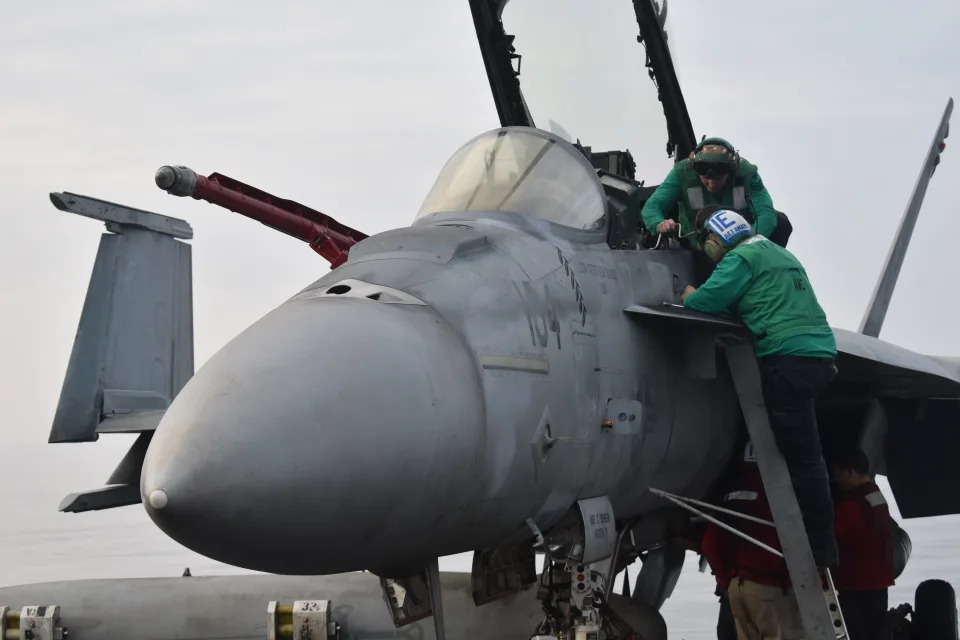
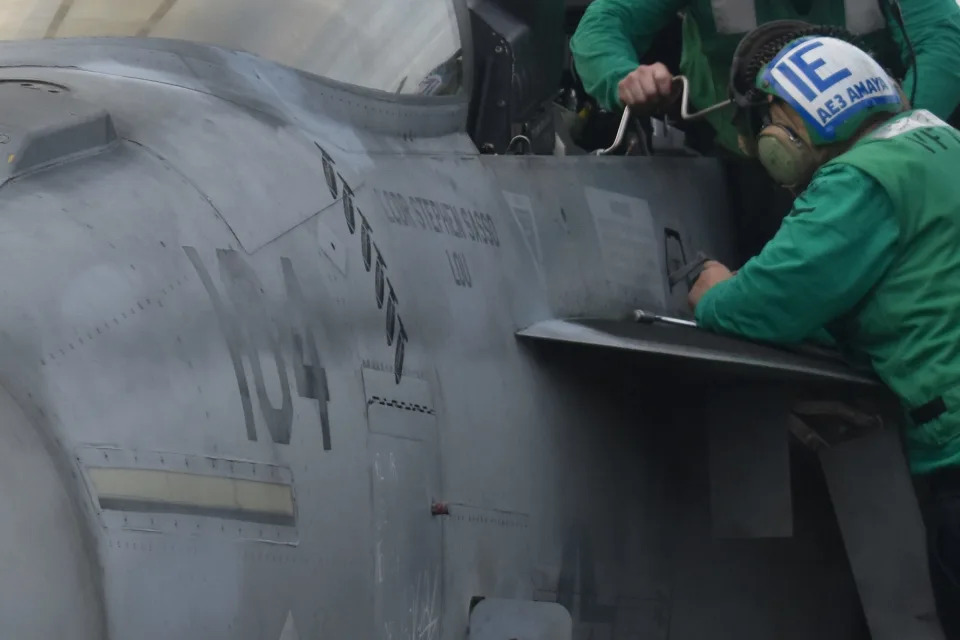
The painted silhouettes photographed by BI, the BBC, and the Navy resemble kill marks, or victory marking, which typically refers to systems that were shot down by an aircraft's crew in aerial engagements. This practice has a long history dating back to World War I and has been used by other militaries beyond the US.
US Central Command, or CENTCOM, did not immediately respond to BI's request seeking clarification on the markings in the photo published by the Navy last week, nor did it specify what munitions have been released by fighter jets in the Ike's carrier air wing.
For months, US and allied warships and aircraft have been destroying deadly threats like anti-ship ballistic and cruise missiles, one-way attack drones, and unmanned underwater and surface vessels, as they defend international shipping lanes off the coast of Yemen from unrelenting Houthi attacks.
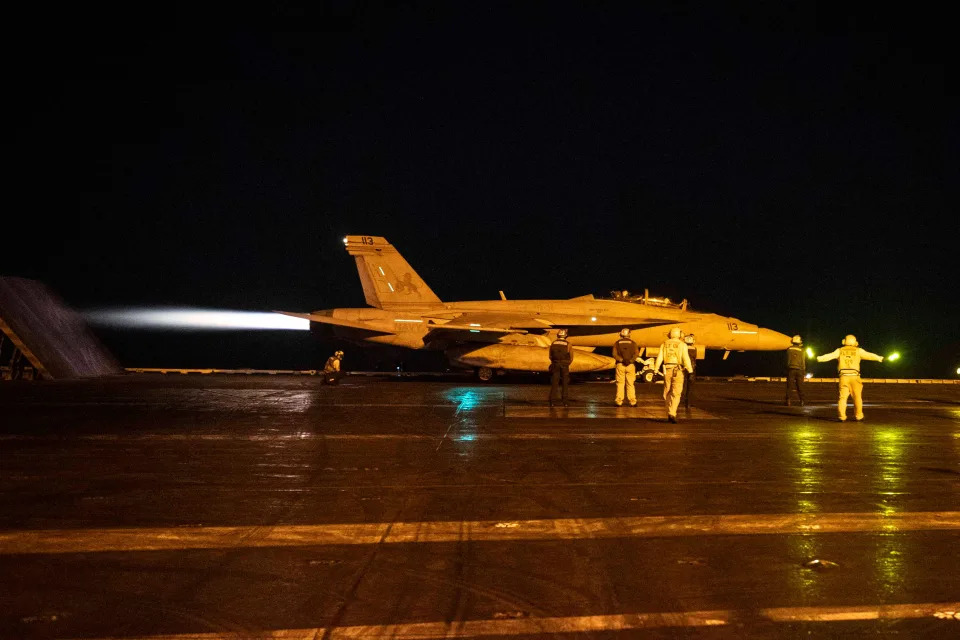
Some of the Houthi missiles and drones have successfully scored hits on commercial ships transiting these key Middle Eastern waters, although the incidents mostly caused minor damage and did not prevent the vessels from continuing on with their journeys.
But in recent weeks, the Houthis have managed to both sink a vessel and kill civilian crew members for the first time in two separate attacks involving anti-ship ballistic missiles.
US forces are now engaging the Houthis — either through preemptive strikes or intercepting their threats in the air — on a routine basis, raising questions about the sustainability of the US-led coalition as it continues to expend resources and munitions.
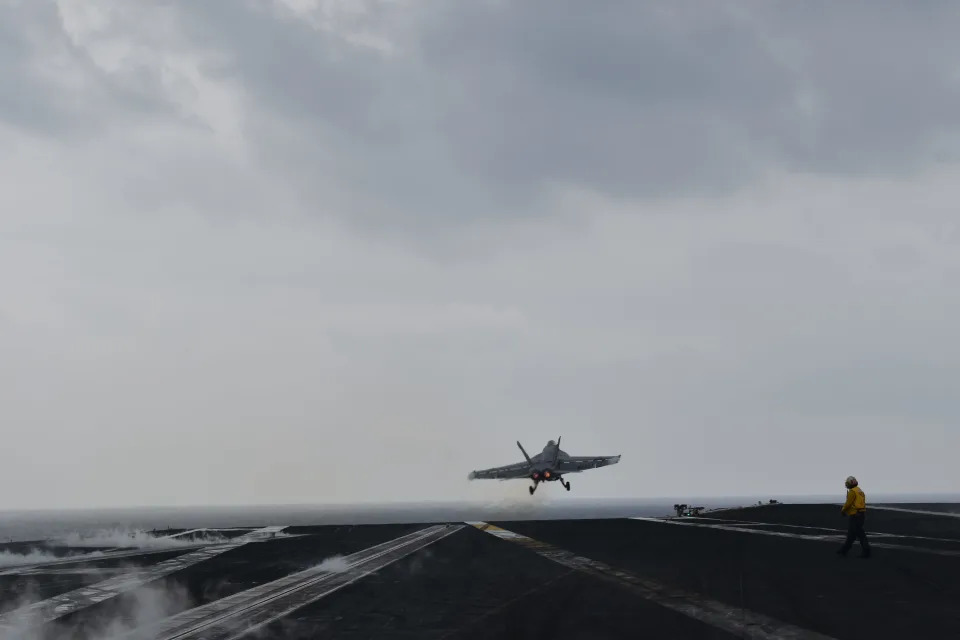
Navy leadership, however, has stressed that Carrier Strike Group 2 — which consists of the Ike, four destroyers, and a cruiser — will stay in the region for as long as they're needed.
Pentagon officials continue to emphasize that the preemptive strikes in Yemen are chipping away at the Houthi arsenal and capabilities, but they acknowledge that the rebels continue to receive weaponry and support from Iran.
"We're under no impression that we have completely wiped off the map all of the Houthis' capabilities," Deputy Pentagon Press Secretary Sabrina Singh told reporters last week. "We know that they continue to have a robust arsenal, they continue to threaten commercial shipping."


